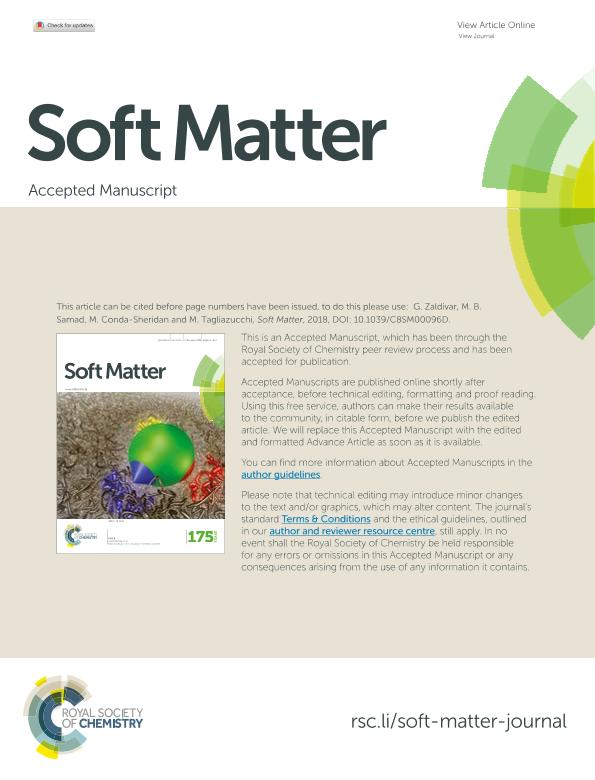Mostrar el registro sencillo del ítem
dc.contributor.author
Zaldivar, Gervasio

dc.contributor.author
Samad, M. B.
dc.contributor.author
Conda Sheridan, Martin

dc.contributor.author
Tagliazucchi, Mario Eugenio

dc.date.available
2019-11-25T17:30:29Z
dc.date.issued
2018-09
dc.identifier.citation
Zaldivar, Gervasio; Samad, M. B.; Conda Sheridan, Martin; Tagliazucchi, Mario Eugenio; Self-assembly of model short triblock amphiphiles in dilute solution; Royal Society of Chemistry; Soft Matter; 14; 16; 9-2018; 3171-3181
dc.identifier.issn
1744-683X
dc.identifier.uri
http://hdl.handle.net/11336/89672
dc.description.abstract
In this work, a molecular theory is used to study the self-assembly of short diblock and triblock amphiphiles, with head-tail and head-linker-tail structures, respectively. The theory was used to systematically explore the effects of the molecular architecture and the affinity of the solvent for the linker and tail blocks on the relative stability of the different nanostructures formed by the amphiphiles in dilute solution, which include spherical micelles, cylindrical fibers and planar lamellas. Moreover, the theory predicts that each of these nanostructures can adopt two different types of internal organization: (i) normal nanostructures with a core composed of tail segments and a corona composed of head segments, and (ii) nanostructures with a core formed by linker segments and a corona formed by tail and head segments. The theory predicts the occurrence of a transition from micelle to fiber to lamella when increasing the length of the tail or the linker blocks, which is in qualitative agreement with the geometric packing theory and with experiments in the literature. The theory also predicts a transition from micelle to fiber to lamella as the affinity of the solvent for the tail or linker block is decreased. This result is also in qualitative agreement with experiments in the literature but cannot be explained in terms of the geometric packing theory. The molecular theory provides an explanation for this result in terms of the competition between solvophobic attractions among segments in the core and steric repulsions between segments in the corona for the different types of self-assembled nanostructures.
dc.format
application/pdf
dc.language.iso
eng
dc.publisher
Royal Society of Chemistry

dc.rights
info:eu-repo/semantics/openAccess
dc.rights.uri
https://creativecommons.org/licenses/by-nc-sa/2.5/ar/
dc.subject
Amphiphile
dc.subject
Self-assembly
dc.subject
Micelle
dc.subject
Molecular Theory
dc.subject.classification
Físico-Química, Ciencia de los Polímeros, Electroquímica

dc.subject.classification
Ciencias Químicas

dc.subject.classification
CIENCIAS NATURALES Y EXACTAS

dc.title
Self-assembly of model short triblock amphiphiles in dilute solution
dc.type
info:eu-repo/semantics/article
dc.type
info:ar-repo/semantics/artículo
dc.type
info:eu-repo/semantics/publishedVersion
dc.date.updated
2019-10-16T15:23:27Z
dc.journal.volume
14
dc.journal.number
16
dc.journal.pagination
3171-3181
dc.journal.pais
Reino Unido

dc.journal.ciudad
Cambridge
dc.description.fil
Fil: Zaldivar, Gervasio. Consejo Nacional de Investigaciones Científicas y Técnicas. Oficina de Coordinación Administrativa Ciudad Universitaria. Instituto de Química, Física de los Materiales, Medioambiente y Energía. Universidad de Buenos Aires. Facultad de Ciencias Exactas y Naturales. Instituto de Química, Física de los Materiales, Medioambiente y Energía; Argentina
dc.description.fil
Fil: Samad, M. B.. University of Nebraska; Estados Unidos
dc.description.fil
Fil: Conda Sheridan, Martin. University of Nebraska; Estados Unidos
dc.description.fil
Fil: Tagliazucchi, Mario Eugenio. Consejo Nacional de Investigaciones Científicas y Técnicas. Oficina de Coordinación Administrativa Ciudad Universitaria. Instituto de Química, Física de los Materiales, Medioambiente y Energía. Universidad de Buenos Aires. Facultad de Ciencias Exactas y Naturales. Instituto de Química, Física de los Materiales, Medioambiente y Energía; Argentina
dc.journal.title
Soft Matter

dc.relation.alternativeid
info:eu-repo/semantics/altIdentifier/url/https://pubs.rsc.org/en/content/articlelanding/2018/sm/c8sm00096d#!divAbstract
dc.relation.alternativeid
info:eu-repo/semantics/altIdentifier/doi/http://dx.doi.org/10.1039/C8SM00096D
Archivos asociados
